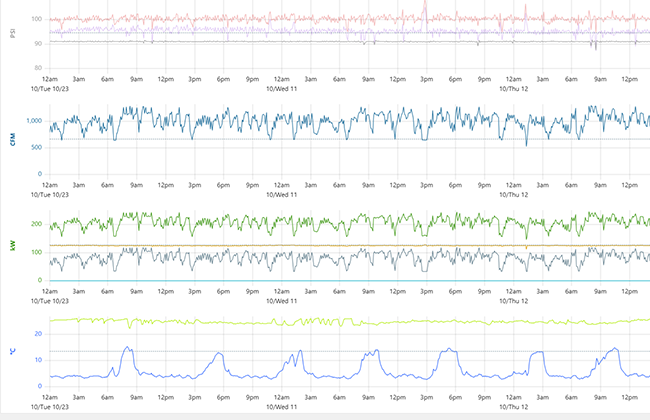A compressed air auditor was hired to have a close look at the main compressed air system at a farm implement manufacturing plant. Data collection instruments were placed on the system to measure pressure, flow, and power. The auditor also placed a dewpoint meter at the discharge of the compressor room, after the main air dryer, and a temperature monitor to measure the cooling air.
When looking at the profile, the auditor immediately discovered bumps in the time-based dewpoint readings. High readings were being encountered about two times per day for some reason (Fig. 1). The bumps did not coincide with any high flow events or compressor cooling air overheating, so this was a “head scratcher” sort of problem.

A detailed investigation revealed that the dryer drain was failing and operating intermittently. The drain had an alarm light blinking showing it had a fault, but maintenance personnel did not notice this item.
 These dewpoint excursions had the real possibility of causing production defects because the dewpoint was occasionally reaching near ambient temperatures. Once the “pressure dewpoint” exceeds the ambient temperature, water will condense out of the compressed air and form free water that can travel downstream into critical tools and equipment.
These dewpoint excursions had the real possibility of causing production defects because the dewpoint was occasionally reaching near ambient temperatures. Once the “pressure dewpoint” exceeds the ambient temperature, water will condense out of the compressed air and form free water that can travel downstream into critical tools and equipment.
This location had two powder painting lines that were installed to ensure a high quality finish on the final product. Water contamination could cause paint defects requiring expensive rework.
A key recommendation at this site is regular testing of condensate drains but also the installation of permanent dewpoint monitoring, with alarm function, to detect when problems occur. The dew point indicator on a refrigerated air dryer should not be relied upon to detect drain failures, the reading is simply the temperature inside the dryer, not the actual dewpoint.
When measuring compressed air systems, it is always important to measure parameters like dewpoint.
Filed Under: Components Oil Coolers, Compressed Air Technologies, Pneumatic Tips